The
Brazil - Malvinas Confluence
Alberto R. Piola 1,
Alejandro A. Bianchi 1,
Andres L. Rivas 2,
Elbio D. Palma3,
Ricardo P. Matano4
and
Rainer Bleck5
1.
Departamento Oceanografia, Servicio de Hidrografia Naval, Buenos Aires, Av.
Montes de Oca 2124, 1271 Buenos Aires,
and Departamento de Ciencias de la Atmosfera y los Oceanos, Universidad de
Buenos Aires, Argentina
2. Centro Nacional Patagonico, 9120 Puerto Madryn, Chubut, Argentina
3. Departamento de Física, Universidad
Nacional del Sur, 8000 Bahía Blanca, Argentina
4. College of Oceanic and Atmospheric Science, Oregon State University,
Corvallis, Oregon 97331, USA
5. Los Alamos National Laboratory, Los Alamos, New Mexico 87545, USA
contact:
Alberto Piola - apiola@hidro.gov.ar
1.
Introduction
2. Water Masses and Cross-Frontal Mixing
3.
Circulation and Volume Transport
4.
Variability
5.
Acknowledgements
6.
References
Forum
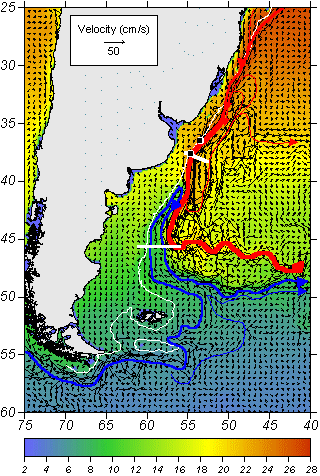 1.
Introduction
1.
Introduction
The
Brazil Current is the western limb of the South Atlantic subtropical gyre.
It carries warm and salty waters poleward along the continental slope of South
America and
near 39° S it collides with a northward branch of the Antarctic
Circumpolar Current (ACC): the Malvinas (Falkland) Current (MC). The MC
transports cold and relatively fresh subantarctic waters equatorward.
The collision between these distinct water masses generates one of the
most energetic regions of the world ocean: the Brazil/Malvinas Confluence (BMC,
hereafter).
Figure
1:
January snapshot of the upper layer horizontal velocity and
temperature fields derived from the Miami Isopycnal Coordinate Model (Micom).
The red and blue lines show schematically the regions of higher velocity and
where the flow is relatively well organized. The thick blue line
represents the Malvinas Current and the Malvinas Return and the thick red line
represents the Brazil Current. Note the tight recirculation cells in both,
poleward and equatorward western boundary currents..
The thick white lines indicate two hydrographic sections (Figures
2a and 2b) occupied in September
1997. The line near 38°S also indicates the position of the geostrophic
velocity section shown in Figure 4. The large dots
indicate the location of two inverted echosounders (see Figure
7). The thin white contour is the 200 m isobath.
Top Introduction
Water Masses
Mixing
Circulation
Variability
References
Forum
2.
Water Masses
The poleward penetration of
subtropical waters associated to the Brazil Current and the equatorward
penetration of subantarctic waters associated to the Malvinas Current lead
to the complex vertical structure of water masses observed in western Argentine
Basin.
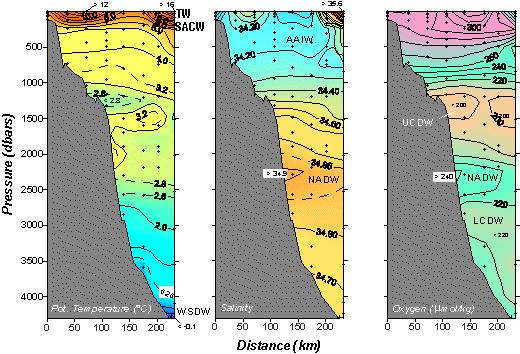 Figure 2a: Potential temperature (q), salinity
and dissolved oxygen sections in a snapshot taken across the BMC (37°S). The property
extremes mark the cores of the following water masses: Tropical Water (TW),
South Atlantic Central Water (SACW), Antarctic Intermeadiate Water (AAIW), Upper
Circumpolar Deep Water (UCDW), North Atlantic Deep Water (NADW), Lower
Circumpolar Deep Water (LCDW) and Weddell Sea Deep Water (WSDW). TW and
SACW are only apparent in the eastern end of the section where q >16°C
and S > 35.5 (Piola and Matano, in press).
Figure 2a: Potential temperature (q), salinity
and dissolved oxygen sections in a snapshot taken across the BMC (37°S). The property
extremes mark the cores of the following water masses: Tropical Water (TW),
South Atlantic Central Water (SACW), Antarctic Intermeadiate Water (AAIW), Upper
Circumpolar Deep Water (UCDW), North Atlantic Deep Water (NADW), Lower
Circumpolar Deep Water (LCDW) and Weddell Sea Deep Water (WSDW). TW and
SACW are only apparent in the eastern end of the section where q >16°C
and S > 35.5 (Piola and Matano, in press).
Further
south, near 46°S (Figure 2b), the upper layers of the Brazil Current turn eastward and
only the northward flowing subantarctic water is found. However,
traces of NADW are present at 2500m. (S > 34.75, O2>210
µmol/Kg). Also the layer of WSDW (q<0°C)
extends about 700m above the seafloor.
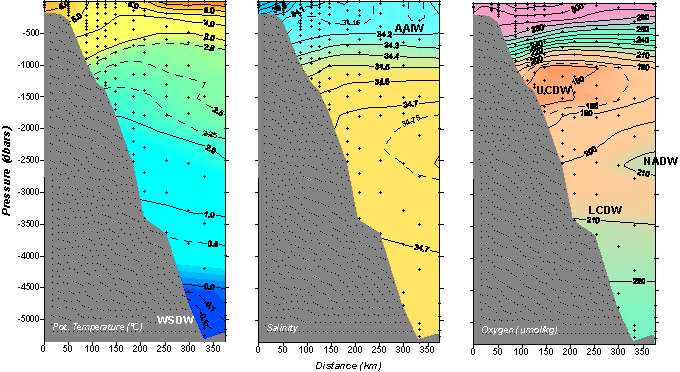
Figure
2b: As in Figure 2a, at 46°S
Top Introduction
Water Masses Mixing
Circulation
Variability
References
Forum
Cross-frontal
Mixing
 CTD observations
from high spatial resolution surveys at the BMC reveal strong interleaving, thermohaline staircases, and evidence of
double diffusion at the interface between SACW and AAIW. Low density
ratios (Rr < 1.7) and Turner angles (TU) in the range
of 67 to 90° are strong indications of saltfingering (Figure 3).
CTD observations
from high spatial resolution surveys at the BMC reveal strong interleaving, thermohaline staircases, and evidence of
double diffusion at the interface between SACW and AAIW. Low density
ratios (Rr < 1.7) and Turner angles (TU) in the range
of 67 to 90° are strong indications of saltfingering (Figure 3).
Figure
3: Temperature and salinity profiles
at the BMC (upper panels), Turner angle (TU, lower left), and density ratio (lower
right). Thermohaline steps are indicated as a, b, c and e. The
shaded region 45°< TU<90° marks the saltfinger regime. Where TU<-45°,
i.e. near 260-280 m, at the base of the cold-low salinity intrusion (step
e), double diffusion convection occurs. Very large buoyancy fluxes are
associated to these interfaces (Bianchi et al., in press).
Model
derived vertical salt fluxes induced by salt fingers are similar to estimates in a Mediterranean salt lens embedded within
NADW. In the warm- salty side of the BMC,
estimates of cross-front integrated salt fluxes using a statistical model
are nearly balanced by salt finger integrated vertical fluxes (Bianchi
et al., 1993).
Top Introduction
Water Masses
Mixing
Circulation
Variability
References
Forum
3.
Circulation and Volume Transport
 The
confluence of subpolar and subantarctic waters at the BMC induces a strong
baroclinic jet with surface velocities frequently higher than 1m/s (e.g. Figure
4).
The
confluence of subpolar and subantarctic waters at the BMC induces a strong
baroclinic jet with surface velocities frequently higher than 1m/s (e.g. Figure
4).
Figure
4: Geostrophic velocity across
the BMC near 38°S (see Figure 1).
Positive values (blues shading) indicate northward flow and negative values
(green and red shading) indicate southward flow. The contour
interval is 10 cm/s except for the dashed contours which correspond to -3cm/s
and 3cm/s. The heavy dotted lines are the 25.5, 27.1, 27.4, and 27.7 kg/m3
isopycnals, which mark the transition between TW, SACW, AAIW and UCDW.
The net relative geostrophic volume transports in this section are 10.6 Sv (1 Sv
= 106
m3/s) northward, associated to the Malvinas Current and 35.1 Sv southward, associated to the Brazil/Malvinas Confluence.
The use of velocities derived from surface drifters
(Peterson et al., 1996) and deep floats (800-1000m) in the geostrophic
calculation increases the volume
transport of the Malvinas Current at 38°S to 25.3 Sv. At 43°S the
adjusted transport increases to 47 Sv, which is in close agreement with 41.5 ±
12 Sv mean transport derived from 8 months of direct current measurements at
40°S (Vivier and Provost, 1999) but is substantially lower than the 75 Sv at
42°S based on mass conservation arguments (Peterson, 1992) .
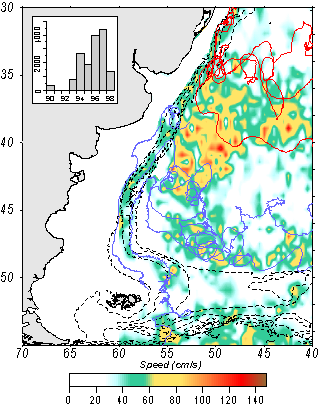 The
surface speed field (Figure 5) shows a region of speeds greater than 60 cm/s in
the southward extension of the Brazil Current, and further south, along the
Malvinas return (see Figure 1 and Figure
6). This high speed region resembles the C-shaped region of high eddy
kinetic energy (Piola et al., 1987) and sea
surface height variability characteristic of the western Argentine Basin (Chelton
et al., 1990). Surface speeds within the core of the Mavlinas Current,
found close to the location of the 1500 m isobath, vary from 50 to 75
cm/s.
The
surface speed field (Figure 5) shows a region of speeds greater than 60 cm/s in
the southward extension of the Brazil Current, and further south, along the
Malvinas return (see Figure 1 and Figure
6). This high speed region resembles the C-shaped region of high eddy
kinetic energy (Piola et al., 1987) and sea
surface height variability characteristic of the western Argentine Basin (Chelton
et al., 1990). Surface speeds within the core of the Mavlinas Current,
found close to the location of the 1500 m isobath, vary from 50 to 75
cm/s.
Figure
5: Surface speed distribution in the western South Atlantic derived from 87 WOCE SVP drifters
between 1990 and 1998 (15449 drifter days). The inset shows the number of
drifter days per year. For reference, also shown here are the tracks of seven drifters
deployed in the Malvinas Current (in blue) and in the Brazil Current (in
red). The dashed lines indicate the 200 m, 1000 m, 2000 m and 3000 m
isobaths.
An
eddy resolving numerical model of the BMC and the adjacent continental shelf is
being developed (see Figure 6). The model is based on the Princeton Ocean
Model (POM) and uses a variable horizontal grid (4 km near the coast to 40 km
offshore) and 25 vertical levels and uses GTOPO30 bathymetry. The model is
being initialized by the Levitus annual mean temperature and salinity and is
forced by the mean annual winds of Hellerman and Rosenstein (1983). Barotropic transports and sea surface elevation are interpolated
from POCM_4 runs (annual mean) and prescribed at the three open boundaries".
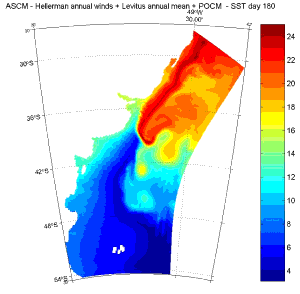
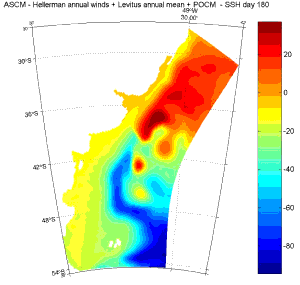
Figure
6: Sea surface temperature (left panel, °C)
and sea surface height (right panel, cm) from the regional POM model runs, day
180. These preliminary model runs show the development of warm and
cold core eddies, meanders and filaments.
Top Introduction
Water Masses
Mixing
Circulation
Variability
References
Forum
4. Variability
The BMC experiences meridional fluctuations of several hundred
kilometers (Olson et al., 1988; Bianchi and Garzoli, 1997). At the annual time scale the BMC variability is characterized by an equatorward displacement of the front during the austral winter and a poleward
displacement during the austral summer. Observations and models indicate that the seasonal displacements of the front might be
linked to variations in the poleward transport of the Brazil Current (Matano et al., 1993). The seasonal cycle observed in the equatorward
transport of the Malvinas Current appears to be too small to have any significant impact on the displacements of the front
(Vivier and Provost, 1999). It is expected that variations in the Malvinas
transport will play an important role in the variability of the front at intra- and interannual time scales.
Migrations of the BMC cause sea surface temperature
anomalies (SSTA) of several degrees, which are thought to impact on the regional
climate. Time series of the mean temperature of the upper 500m, constructed
from an array of IES, also reveal large variations associated to northward excursions of the
Malvinas Current with a persistence of 15 to 60 days (Figure 7) and frontal
motions of 0.2 m/s. Rainfall anomalies over Uruguay, which setup late in El Niño
years, are also associated to SSTA in the western Argentine
Basin. The precipitation record over Uruguay and the SSTA over the
western South Atlantic are coherent (>0.8) and 90° out of phase (Podestá et
al., unpublished, see Garzoli et al., 1996).
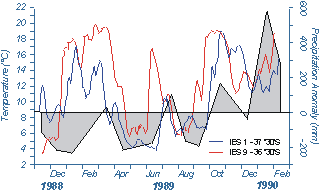 Figure 7: Mean temperature in the upper 500m derived from two IES located at 37°30'S
(blue, IES 1) and 36°30'S (red, IES 9) on the 2000m isobath. The low temperature periods observed in
December 1988 and May-September 1989 are associated to northward penetrations of
the Malvinas Current and offshore displacements of the BMC while in January,
late February and June-July 1989 the front displaced shoreward and southward, past the array (from Bianchi
and Garzoli, 1997). The gray shading is the first principal component of
the rainfall anomaly over Uruguay (from Podestá et al., unpublished).
Figure 7: Mean temperature in the upper 500m derived from two IES located at 37°30'S
(blue, IES 1) and 36°30'S (red, IES 9) on the 2000m isobath. The low temperature periods observed in
December 1988 and May-September 1989 are associated to northward penetrations of
the Malvinas Current and offshore displacements of the BMC while in January,
late February and June-July 1989 the front displaced shoreward and southward, past the array (from Bianchi
and Garzoli, 1997). The gray shading is the first principal component of
the rainfall anomaly over Uruguay (from Podestá et al., unpublished).
Top Introduction
Water Masses
Mixing
Circulation
Variability
References
Forum
5.
Acknowledgements
This
work is supported by the Inter-American Institute for Global Change Research,
Agencia Nacional de Promoción Científica y Tecnológica, Argentina (ARP, ALR
and EDP) and NSF
grant OPP
95-27695 and JPL contract 1206714 (RPM).
6.
References
Bianchi,
A.A., C.F. Giulivi and A.R.
Piola, 1993, Mixing in the Brazil/Malvinas Confluence, Deep-Sea Res., 40,
1345-1358.
Bianchi,
A.A. and S.L. Garzoli, 1997, Variability and motion of the Brazil-Malvinas
front, Geoacta, 22, 74-90.
Bianchi.,
A.R. Piola and G. Collino, Evidence of double diffusion in the Brazil/Malvinas
Confluence, Deep-Sea Research,
in
press.
Chelton, D. B., M. G. Schlax, D. L. Witter, and J. Richman,
1990, Geosat altimeter observations of the surface circulation of the southern ocean. J.
Geophys. Res., 95, 17,877-17,903.
Garzoli,
S.L., D.B. Olson, E. Chassignet, R. Matano, H. Berbery, E. Campos, J. Miller, A. Piola,
G. Podesta, R. Fine and R. Molinari, 1996, SACC: South Atlantic Climate Change, Draft Document,
unpublished.
Hellerman,
S., and M. Rosenstein, 1983, Normal monthly wind stress over the world ocean
with error estimates. J.
Phys.Oceanogr. 13, 1093-1104.
Matano,
R.P., M.G. Schlax and D.B. Chelton, 1993, Seasonal variability in the
Southwestern Atlantic, J. Geophys. Res., 98, 18027-18035.
Olson,
D. B., G. P. Podestá, R. H. Evans, and O. Brown, 1988: Temporal variations in
the separation of the Brazil and Malvinas currents, Deep-Sea Res., 35,
1971-1990.
Peterson,
R. G., 1992, The boundary currents in the western Argentine Basin, Deep
Sea Res., 39, 623-644.
Peterson,
R.G, C.S. Johnson, W. Krauss and R.E. Davis, 1996, Lagrangian measurements in
the Malvinas Current, in: The South Atlantic: Present and past circulation,
Springer-Verlag, Berlin, 239-247.
Piola,
A.R., H.A. Figueroa and A.A. Bianchi, 1987, Some aspects of the surface
circulation south of 20°S revealed by First GARP Global Experiment Drifters, J.
Geophys.
Res.,
92, 5101-5114.
Piola,
A.R. and R.P. Matano, Atlantic Western Boundary - Brazil Current/Falkland (Malvinas)
Current, in: Encyclopedia of Ocean Sciences, Academic Press, in press.
Vivier,
F. and C. Provost, 1999, Volume transport of the Malvinas Current: Can the flow
be monitored by Topex-Poseidon?, J.
Geophys. Res., 104, 21105-21122.
Top Introduction
Water Masses
Mixing
Circulation
Variability
References
Forum
 1.
Introduction
1.
Introduction



 The
surface speed field (Figure 5) shows a region of speeds greater than 60 cm/s in
the southward extension of the Brazil Current, and further south, along the
Malvinas return (see
The
surface speed field (Figure 5) shows a region of speeds greater than 60 cm/s in
the southward extension of the Brazil Current, and further south, along the
Malvinas return (see 

